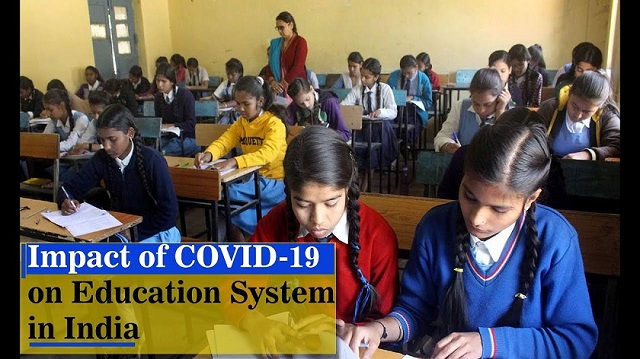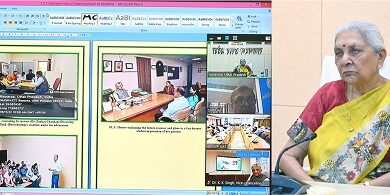
IMPACT OF COVID-19 ON EDUCATION SYSTEM
INTRODUCTION
COVID-19 the widespread pandemic has intimidated the human race to its widest extent. It has impacted the course of our social life drastically. This unprecedented pandemic has left every one of us in a state of anxiety, anguish, and distress.
Due to the pandemic, all educational institutions have been temporarily closed in order to curb its spread. This has adversely affected our practical means of education. But it has also paved the way to an E-platform which looks very much conventional in these trying times.
All over the world governments have welcomed a new form of learning (E-platforms) in order to mitigate and avoid the vulnerable situation and facilitate remote learning.
Reports by UNESCO estimate that about 32 crores of students are affected in India. Therefore the government has come up with E-learning methods. This medium which initially looked far from pragmatism, has gained overwhelming responses from the students.
It has facilitated more significant educational resources and proved to be fruitful to the academicians. It has provided a viable solution to the intervention caused by the pandemic. It has also brought the access of digital platforms into the limelight, which was all set to be on the mainstream of education. It has served to be a prototype of future expectations in the field of academics.
MERITS OF E-LEARNING
It lacks the spirit of competitiveness and creativity but provides a comfort zone to students. The students-teacher digital learning is feasible and user friendly in this time of immeasurable sufferings. This pandemic has introduced us to a more engaging, personalized and enjoyable academia learning.
India has already set the tone for a digital revolution. Due to the large count of students, India may open gateways to massive open online courses. Through the use of technology, we may provide a strong alternative to the conventional education system. Mitigating and compensating with the hindrances imposed and inconvenience caused, by the pandemic on education E-learning has proved to a relieving factor.
Learning is said to be an ever-evolving and continuous process. The educational institutions in India, from schools and universities, can use the current adversity as a blessing in disguise. It could serve as a great time and pave the way for learners in future. But only a handful of private schools can adopt online teaching methods.
The low-income counterparts (governmental institutions) have found it quite challenging to get access to e-learning. The pandemic has been a setback to the section of higher education, which is supposed to be a critical factor in the country’s economic future. The condition in Latin Countries is much horrifying. If the situation persists the same way in the long run, a decline in the demand for international higher education is expected.
There is still the hung situation amidst this situation of uncertainty. The school and colleges have been put to closure for almost three months now. This is a crucial time for the education sector because all-important academic activities such as school admissions, entrance tests of various universities and competitive examinations were supposed to have taken place by now.
The pivotal axis of the traditional style of teaching may have very briskly be shifted towards the platform of digital media, but the adaptability and accessibility of it to the lower economic section would be subject much to be discussed.
However, for the majority of students, it has proved to be a boon in this plight. The situation which seems with all probable to persist for a long time needs a solution which should be much resilient. In this vulnerable situation, e-learning has proved to be a rescue option for most of the schools and educators, with the current use of technology the digital learning seems to have wider scope in the nearest future.
With a rapid increase of mobile internet users in India, which is expected to reach 84% of the total population households by 2024 technology would avail greater excess and personalization of education even to the remotest part of the country.
The technology has evolved with each passing day and played a vital role to mitigate the effect of a pandemic on the job, internship programmes and research projects. There are different platforms and sources, made easily accessible by means of digital library and different online quality courses on the same subject in which the assessment would be done on a set pattern of methodology and assessment parameters.
This condition has put forward a solid foundation to facilitate the inclusion of digital learning in mainstream education. The imposed challenges by the pandemic in conducting the examination seemed to be a serious threat to the safety and health of the students. With the help of various conferencing options as well as offline examination resources, the condition could be dealt with smoothly.
Digital learning has left behind the shortcomings of physical boundaries; the student could easily be confined to their safety zones and could be properly assessed also. The students in the containment zones and hotspot could take their examinations with a proper safe environment. But there are serious challenges posed because the students living in the urban area have the facilities to opt for digital education, however, rural area students lack the advanced infrastructure some of them are not that financially strong to avail the resources required for digital education.
DEMERITS OF E-LEARNING
The use of digital media seems to be fascinating and handy, but there are serious implications of it as the students may not be facilitated with a proper classroom environment, and they may easily distract towards social media and gaming apps.
That would largely spoil their continuity, rhythm, and flow of learning, successful delivery of education is the biggest question left unanswered. Secondly, the government of India lacks the budget to implement it to the remotest part of the country. Further, if it has to be in the mainstream of education, proper training has to be given to the teachers to provide uninterrupted, authentic, and proper education to students.
CONCLUSION
The E-learning though looks patchy and scanty but has proved to be a reliable source of learning. With so many different ways to define e-learning and educational approaches that can be taken in these learning environments, the problem stands with unanimity. Due to which there is a glaring disadvantage, the exams could not be conducted.
Through the use of technology, we can if not provide a strong alternative to the conventional educational forum. But surely we can mitigate and compensate with the impediments caused by the COVID. Although there are more inventions required and more resources should avail in order to welcome this newly implemented method for larger proximity. This newly formed method has undeniably left us with a blessing in disguise situation.
By: Shivansh Misra





